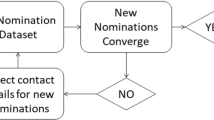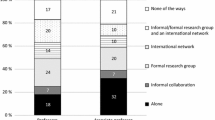Abstract
This article describes the application of co-nomination analysis, a technique designed to map the structure of a research community. The technique was used as part of the evaluation of the UK national information technology programme, which sponsors collaborative research between firms and between firms and universities. Co-nomination networks are based upon responses to questionnaires which researchers are asked to nominate other researchers whose work is similar or relevant to their own. Researchers nominated in the same response are presumed to be linked, and where these links occur with multiple frequency, the likelihood of their being significant is increased. The article describes the extension of a network which had been previously identified and compares the citation scores of researchers identified in the networks. It is concluded that the networks represented were realistic and a useful input to the evaluation. Industrial and government researchers with low citation scores were in some cases central to the networks, suggesting that co-nomination is useful in areas where publication is restricted or considered less important. Further development of the technique is planed.
Similar content being viewed by others
References
L. GEORGHIOU, K. GUY, H. M. CAMERON, M. HOBDAY, T. RAY, R. DUNCOMBE,Evaluation of Alvey-Interim Report, HMSO, London, 1988.
L. GEORGHIOU, H. M. CAMERON, Evaluating the Implementation of the Alvey Programme, Paper presented to OECD Workshop on Evaluating of IT Programmes, Paris, September, 1986.
E. ARNOLD, K. GUY,Parallel Convergence: National Strategies in Information Technology, Frances Pinter, London, 1986.
K. HOFFMAN, Assessing the Technological Performance of the UK Electronics Industry Using Patent Data: Notes on Method and on Illustration, SPRU, University of Sussex, January 1985.
C. J. FARINA, M. GIBBONS, L. GEORGHIOU, “The Domesday Report”, report to Science Research Council, 1977.
L. GEORGHIOU, W. L. GIUSTI, H. M. CAMERON, M. GIBBONS, The use of co-nomination analysis in the evaluation of collaborative research, in: A. F. J. VAN RAAN (Ed.),Elsevier Handbook of Quantitative Studies of Science and Technology, Elsevier, 1988.
R. DUNCOMBE, B. EVANS, K. GUY, Academic institutions in the Alvey MMI Programme, a report to the Alvey Directorate, SPRU, University of Sussex, December 1987, IEE, London (forthcoming 1988).
Author information
Authors and Affiliations
Additional information
Order of names implies no precedence.
Rights and permissions
About this article
Cite this article
Giusti, W.L., Georghiou, L. The use of co-nomination analysis in real-time evaluation of an R&D programme. Scientometrics 14, 265–281 (1988). https://doi.org/10.1007/BF02020079
Received:
Issue Date:
DOI: https://doi.org/10.1007/BF02020079




